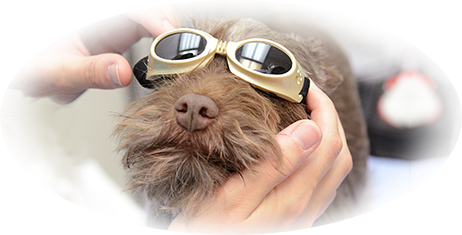
Get Enlightened about LASER Therapy
Veterinarians have learned a lot about how animals experience pain over the last thirty years.
When I graduated from vet school in 1985, we were instructed that animals feel less pain and handle pain much better than their human counterparts. We were told that a little pain is OK because it discourages activity and that the resulting rest helps healing.
That made a little sense but it still didn’t feel right to me.
Veterinarians are taught comparative anatomy in the early years of vet school. We look at the body systems of many species and compare their development and function. There is very little difference in the function and nervous systems of all mammalian species – this includes us and our furry friends.
If we feel pain … then your pet feels pain to the same degree. They just can’t communicate their pain and THAT is the problem.
Vets and animal technicians are getting better at identifying pain and more importantly treating pain appropriately. Thankfully, information and aids to treat pain have exploded over the last 15 years. Vets have many ways to treat pain.
At Truro Vet, we have a new cutting edge, scientifically proven way to treat pain … LASER therapy.
You might ask – how, on earth doe light waves treat pain?
Answer is PHOTO-BIO-MODULATION.
There has been a lot of interesting research in this field called photo- bio- modulation lately.
In a nutshell, laser therapy accelerates the body’s natural healing process through photo-bio-modulation. Laser therapy provides tangible health benefits to your pet. Laser therapy is effective in treating chronic conditions, acute conditions, and post- surgical pain and inflammation.
How does it work?
Decades of research, clinical trials, and laboratory testing indicate the following beneficial effects of laser therapy. Some of this is ‘tech talk’ so I translated in the italics at the end of each paragraph:
Anti-Inflammation
Laser therapy reduces inflammation with vasodilation, activation of the lymphatic drainage system, and reduction of pro-inflammatory mediators. As a result, inflammation, erythema, bruising, and edema are reduced. Reduce the swelling – reduces the pain.
Analgesic Effect
Laser therapy of diseased and damaged tissue produces a suppression of nociceptors, an increase of stimulation threshold, and an increased release of tissue endorphins. The result is a decreased patient perception of pain. Numbs the nerves so they send less messages to the brain that feels like pain.
Accelerated Tissue Repair and Cell Growth
Photons of light from lasers penetrate deeply into tissue and accelerate cellular reproduction and growth. Laser light increases the energy available to the cells so that they can take on nutrients and get rid of waste products more quickly. Promotes cell growth and speeds healing.
Improved Vascular Activity
Laser light significantly increases the formation of new capillaries in damaged tissue. This speeds the healing process, resulting in more rapid wound closure. More blood supply allows the building blocks of repair travel to the diseased treated area faster.
Increased Metabolic Activity
The energy from photons of laser light is captured by chemical complexes within cells resulting in activation of enzyme systems and increased energy delivered into cellular metabolic processes. If healing cells have more energy – they can speed up the healing process.
Trigger Points and Acupuncture Points
Laser therapy stimulates muscle trigger and acupuncture points without mechanical invasion to provide musculoskeletal pain relief. Needleless acupuncture.
Reduced Fibrous Tissue Formation
Laser therapy reduces the formation of scar tissue. More healing and less scars – on the skin and inside the body.
Improved Nerve Function
Slow recovery of nerve functions in damaged tissue results in numbness and impaired limbs. Laser therapy accelerates nerve cell regeneration. Speeds up the growth and repair of damaged nerves.
Immunoregulation
Therapy laser photons have an effect on immune systems status through stimulation of immunoglobins and lymphocytes. Laser therapy energy is absorbed by chromophores (molecular enzymes) that react to laser light. The enzyme flavomono-nucleotide is activated and starts the production of ATP, which is the major carrier of cellular energy and the energy source for all chemical reactions in the cells. Increases energy of cells that support the immune system.
Faster Wound Healing
Laser light stimulates fibroblast development. Fibroblasts produce collagen, which is predominant in wound healing in damaged tissue. Collagen is the essential protein required to replace old tissue or to repair tissue injuries. As a result, laser therapy is effective on open wounds and burns. Faster healing – this is especially obvious on patients with skin wounds or skin disease.

0 Comments